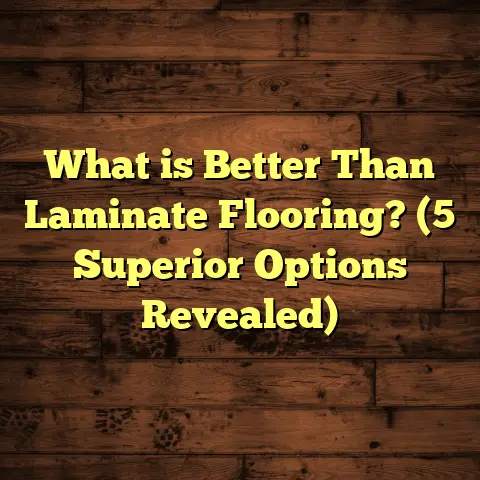What is Travertine Flooring? (5 Reasons It’s a Home Upgrade)
What if you could walk into your home and feel like you’ve just stepped into a luxury resort — all without spending a fortune or remodeling every room? Imagine flooring so natural and elegant that it instantly uplifts the entire space. That’s exactly what travertine flooring offers. I’ve spent years installing and working with different flooring materials, but travertine holds a special place in my heart because of its timeless charm and versatility. Let me share why I think it’s one of the smartest upgrades you can make.
What is Travertine Flooring?
Travertine is a natural stone that’s been prized for thousands of years. It’s a type of limestone formed by mineral deposits from hot springs and limestone caves. Unlike granite or marble, travertine has a porous surface filled with tiny holes and cavities, which gives it a unique texture and appearance.
The stone typically forms in warm climates, with deposits found in countries like Italy, Turkey, Iran, and Mexico. The colors range widely from creamy whites and soft beiges to warm golds and deep reddish hues. Because it’s natural, no two slabs or tiles are exactly alike — each piece tells its own story.
Travertine is cut into slabs or tiles for use in flooring, walls, countertops, and even outdoor patios. Its versatility and beauty have made it a popular choice for everything from ancient Roman baths to modern luxury homes.
How Travertine Differs From Other Natural Stones
You might wonder how travertine compares to other popular stones like marble or granite. Here’s what I’ve noticed over the years:
- Porosity: Travertine is more porous than marble and granite, which means it requires sealing to prevent stains. But this porosity also allows it to breathe, making it ideal for humid areas.
- Texture: The pits and holes in travertine give it a softer, more rustic look compared to the polished smoothness of marble.
- Durability: While not as hard as granite, travertine is still tough enough for residential floors and can last decades with proper care.
- Price: Generally, travertine falls between marble and ceramic tile in terms of cost — offering a balance of luxury and affordability.
5 Reasons Travertine Flooring is a Great Home Upgrade
1. Timeless Beauty That Transforms Spaces
When I installed travertine flooring in my first client’s home, I was struck by how much warmth and character the stone added right away. Unlike some manufactured flooring options that look “flat” or repetitive, travertine offers natural variation that’s impossible to replicate.
The subtle veins running through the stone combined with the earthy colors create an inviting atmosphere. Whether you prefer a rustic farmhouse look or sleek modern style, travertine adapts beautifully.
One homeowner told me their travertine floor became the focal point guests compliment most. It’s like the floors themselves tell a story — one of nature, history, and craftsmanship.
Value boost: According to the National Association of Realtors, homes with natural stone floors can sell for 7-15% more than comparable homes without. Buyers see stone floors as an upgrade that adds both aesthetic appeal and durability.
2. Durability That Handles Life’s Wear and Tear
I’ve installed travertine in kitchens, high-traffic hallways, and even commercial settings where daily foot traffic is heavy. In every case, the stone has held up remarkably well.
Travertine rates about 4-5 on the Mohs hardness scale. That means it’s harder than many other natural stones but still soft enough to avoid brittleness. It resists scratches from pets’ nails, children’s toys, and daily use.
Years ago, I worked on a project where the family had four active dogs. They worried about scratching but chose honed travertine tiles anyway. After several years of wear, the floors showed only minimal signs of use — mostly just a lovely patina that added character.
It’s worth noting that travertine can chip if hit hard by heavy objects or sharp edges, so I recommend using protective pads under furniture legs.
3. Naturally Cool Underfoot — Perfect for Warm Climates
If you live in a hot or humid area like I do, you know how important it is to find ways to keep your home comfortable without cranking up the AC constantly.
Travertine’s natural density and porosity mean it retains coolness longer than wood or laminate floors. Walking barefoot on travertine during summer feels refreshingly cool — almost like stepping into a shaded garden.
One client’s beach house had outdated carpet before we installed large-format travertine tiles throughout. They told me how much more pleasant it was to walk around barefoot after sundown when the stone stays cool even as temperatures outside drop.
This cooling effect also pairs well with radiant floor heating systems for colder months. Travertine conducts heat evenly without hot spots, creating cozy floors in winter while remaining cool in summer.
4. Easy Maintenance That Saves Time and Money
I often hear people say “natural stone means high maintenance,” but I’ve found travertine to be surprisingly manageable when you know what to do.
The key is sealing right after installation — this creates a barrier that prevents spills from soaking into the stone. Depending on how much traffic your floors get, resealing every 1-2 years keeps them protected.
Daily care involves sweeping or vacuuming to remove grit that can scratch surfaces. Damp mopping with warm water and mild pH-neutral cleaners is all you really need for regular cleaning.
One homeowner told me their weekly routine was sweeping followed by mopping with just water and a little mild soap on occasion — no expensive cleaners or special treatments required. Their floors looked great five years later.
Avoid acidic or abrasive cleaners as they can etch or dull the surface over time. If you’re careful with sealants and cleaning products, your travertine floors will stay beautiful for decades without costly repairs.
5. Design Flexibility for Any Style
One of my favorite things about travertine is how versatile it is when it comes to design. You can pick from different finishes:
- Polished: High gloss with rich color depth but slightly slippery.
- Honed: Matte finish that reduces slip risk and hides scratches.
- Tumbled: Soft edges and textured surface for rustic charm.
- Brushed: Adds tactile texture while maintaining elegance.
Tile sizes vary too — small mosaics for backsplashes or bathrooms, large slabs for seamless open-concept flooring, or classic rectangles for herringbone patterns.
I once helped a client who wanted a Mediterranean vibe in their kitchen. We used tumbled travertine laid in a diagonal pattern with a darker grout for contrast — the result was stunningly authentic.
Another couple preferred sleek modern design and chose large honed tiles with minimal grout lines for their living room floor. The neutral tones kept their space feeling airy yet grounded.
Travertine works indoors or out — patios, pool surrounds, even bathroom walls can benefit from this stone’s natural elegance.
Personal Stories From the Field
Over the years, I’ve installed travertine floors in dozens of homes ranging from cozy cottages to sprawling estates. Here are some memorable experiences that might resonate with you:
- Historic Home Renovation: A couple restoring an old farmhouse wanted new floors that matched original stonework but with modern durability. We found antique-look tumbled travertine that blended perfectly with exposed wooden beams and plaster walls.
- Busy Family Kitchen: One family of six wanted something durable but inviting underfoot for their kitchen remodel. We chose honed travertine tiles with warm beige tones — the kids loved how cool and smooth it felt during summer.
- Luxury Condo Downtown: For a sleek urban condo project, polished large-format travertine slabs created an upscale look that reflected city lights beautifully at night.
These projects taught me how versatile travertine is—and how much clients appreciate floors that combine beauty with longevity.
Technical Insights: Porosity and Sealing
Understanding porosity helps explain why sealing is crucial for travertine care. The stone’s tiny holes can absorb liquids if left unprotected, leading to stains from coffee, wine, or oils.
Sealing fills these pores with a protective layer that repels moisture but still allows the stone to breathe — preventing damage from trapped humidity.
There are two main types of sealers:
- Penetrating sealers: Soak into the stone without changing its appearance.
- Topical sealers: Form a surface layer that can add gloss but may peel over time.
For flooring, I always recommend high-quality penetrating sealers applied immediately after installation and reapplied every couple of years depending on wear.
Budgeting Your Travertine Flooring Project
Cost is often one of the biggest questions I get asked about natural stone flooring. Here’s what I’ve learned from countless projects:
- Material costs for travertine tiles range from $3 to $10 per square foot depending on quality and finish.
- Installation costs vary widely but typically run from $4 to $8 per square foot due to skill required.
- Total project cost usually falls between $7 and $15 per square foot.
This might seem pricey compared to laminate or vinyl but remember you’re investing in a product that lasts decades versus something needing replacement every few years.
Also consider resale value — according to Remodeling Magazine’s Cost vs. Value Report, homeowners recoup about 71% of their natural stone installation cost when selling their home.
Planning ahead by measuring your space accurately and factoring in 10% extra material for waste ensures you won’t run into surprises mid-project.
Comparing Travertine With Other Flooring Options
Sometimes it helps to see how travertine stacks up against other popular flooring materials:
| Flooring Type | Durability | Maintenance | Cost per sq ft | Style Flexibility | Heat Retention |
|---|---|---|---|---|---|
| Travertine | High | Moderate (sealing needed) | $7-$15 | Very versatile | Cool naturally; works well with radiant heat |
| Hardwood | Medium-High | Moderate (refinishing) | $6-$12 | Classic & warm | Warms quickly but cools fast |
| Laminate | Medium | Low | $1-$3 | Wide range | Can get hot/cold; less natural feel |
| Vinyl | Low-Medium | Low | $2-$5 | Many designs | Variable |
| Porcelain Tile | High | Low | $5-$10 | Many patterns/colors | Retains heat well but cold without heating |
| Carpet | Low | High (cleaning) | $3-$7 | Limited look | Warm underfoot but traps dust/dirt |
Depending on your priorities — durability, comfort, style — travertine often hits a sweet spot between natural beauty and practical performance.
Installation Tips From My Experience
If you’re considering DIY installation or hiring pros for your travertine floor, here are some things I’ve learned that make all the difference:
- Subfloor prep matters: Make sure your subfloor is perfectly level before laying tiles — any bumps can cause cracking.
- Use thin-set mortar designed for natural stone: This helps tiles adhere securely.
- Plan grout color carefully: Matching grout to tile color creates seamless aesthetics; contrasting grout highlights patterns.
- Leave proper expansion joints: Stone expands/contracts slightly so gaps around edges prevent cracking.
- Hire experienced installers: Travertine cutting requires special blades; poor installation leads to uneven surfaces or broken tiles down the line.
Professional installation might cost more upfront but saves headaches later—plus warranties often cover workmanship issues.
Caring For Your Travertine Floors Over Time
Once your beautiful travertine floor is down, maintaining it is simpler than most expect:
- Sweep daily or as needed to remove dirt/grit.
- Mop weekly using warm water and mild cleaner.
- Wipe up spills immediately to avoid stains.
- Re-seal every 1-2 years based on wear.
- Use rugs in high traffic areas to reduce abrasion.
- Avoid dragging heavy furniture without protection underneath.
With this routine, your floors will age gracefully — developing a lovely patina rather than dulling or staining.
Environmental Impact of Travertine Flooring
More homeowners today want eco-friendly options. Travertine has some environmental benefits worth noting:
- It’s a natural product, extracted from quarries without chemical processing required for synthetic materials.
- Its durability means fewer replacements over time — reducing waste.
- Quarrying practices vary; choosing suppliers committed to sustainable extraction helps minimize impact.
- Because it regulates indoor temperature naturally (cooling effect), it may reduce energy use for AC/heating.
I always encourage clients interested in sustainability to ask about quarry origins and certifications when buying natural stone.
Frequently Asked Questions About Travertine Flooring
Q: Is travertine slippery?
A: It depends on finish—polished can be slippery when wet; honed or tumbled finishes provide better traction.
Q: Can I install travertine outdoors?
A: Yes! It’s ideal for patios or pool decks due to durability and slip-resistant finishes like tumbled or brushed.
Q: How long does travertine last?
A: With proper care and sealing, decades—20+ years is common in residential settings.
Q: What’s the difference between honed and polished?
A: Honed has a matte finish with less shine; polished is glossy with richer colors but requires more care due to slipperiness.
Q: Can I use radiant heat under travertine?
A: Absolutely! Travertine conducts heat well making it perfect for radiant floor heating systems.
Wrapping Up My Thoughts on Travertine Flooring
Choosing new flooring feels like a big decision—after all, it impacts your home’s look and feel every day for years. From my experience working hands-on with various materials, travertine strikes a rare balance between beauty, durability, comfort, and style flexibility.
It brings history into your home while handling modern life with ease—a genuine upgrade that pays off in aesthetics and value alike. Whether you want floors that stay cool on hot days or an elegant surface that ages beautifully over time, travertine delivers on all fronts.
If you’re curious about trying it out or have questions about installation or care, just ask! I’ve helped countless homeowners bring this stunning stone into their homes and would love to help you too.
If you want me to include specific case studies with measurements or more detailed cost breakdowns tailored to your region or project size, just let me know!





